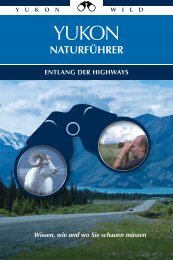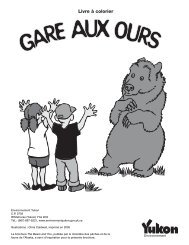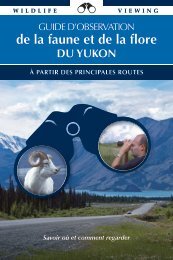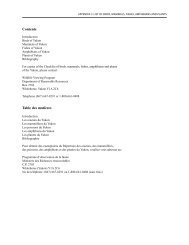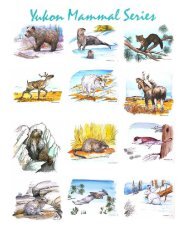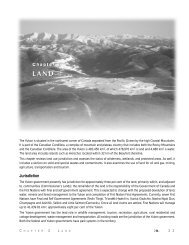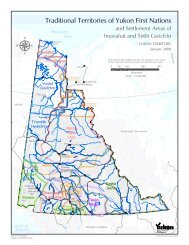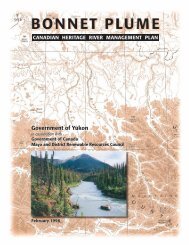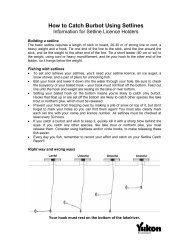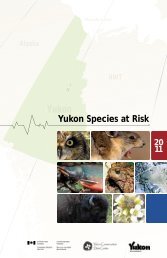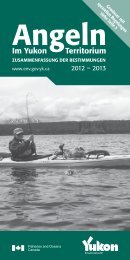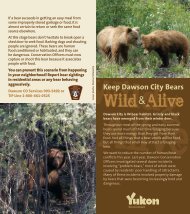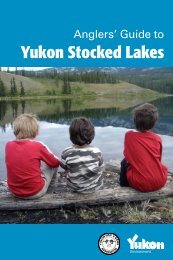Yukon Hunting - Department of Environment - Government of Yukon
Yukon Hunting - Department of Environment - Government of Yukon
Yukon Hunting - Department of Environment - Government of Yukon
You also want an ePaper? Increase the reach of your titles
YUMPU automatically turns print PDFs into web optimized ePapers that Google loves.
42<br />
Moose<br />
Female moose are protected from hunting.<br />
Attaching the Seal<br />
Moose seals can be attached around the base <strong>of</strong> an antler or the tendon <strong>of</strong> a hind<br />
quarter. See page 11 for more information about seals.<br />
Evidence <strong>of</strong> Sex and Species<br />
The head or skull attached to the antlers or the scrotum attached to the carcass are<br />
considered evidence <strong>of</strong> sex for moose. You must keep evidence <strong>of</strong> sex until you get<br />
the carcass home or until a Conservation Officer has inspected it.<br />
Mandatory Kill Reporting<br />
Everyone who kills a moose must report the kill to an <strong>Environment</strong> <strong>Yukon</strong> <strong>of</strong>fice<br />
no later than 15 days after the end <strong>of</strong> the month in which the moose<br />
was killed (or upon the request <strong>of</strong> a Conservation Officer).<br />
When you come into the <strong>of</strong>fice, or report by telephone, our staff will fill out a<br />
form and record the species, sex, location and date <strong>of</strong> your kill. Please ensure<br />
that you have the kill location, sex <strong>of</strong> the animal, date and your hunting<br />
licence and seal number readily available for reference. Reporting only takes<br />
a few minutes <strong>of</strong> your time.<br />
Wanted: biological samples from <strong>Yukon</strong> moose<br />
<strong>Environment</strong> <strong>Yukon</strong> is monitoring diseases and parasites affecting hunted <strong>Yukon</strong><br />
wildlife. We want to learn about the types <strong>of</strong> diseases and parasites that are present,<br />
how many animals are affected, and in which areas <strong>of</strong> <strong>Yukon</strong>. See Monitoring Wildlife<br />
Health on page 6 for more information.<br />
Population Outlook<br />
Overall moose numbers in <strong>Yukon</strong> are thought to be stable at about 70,000 animals.<br />
While the <strong>Yukon</strong>-wide harvest is believed to be within the estimated sustainable limit<br />
<strong>of</strong> 2100 to 3000 moose per year, the harvest in a few areas is near, or may exceed what<br />
is sustainable. These are usually areas with relatively easy access and high hunting<br />
pressure. For example, harvest rates in the McQuesten Lake area north <strong>of</strong> Mayo, and<br />
along the Nisutlin River appear high and are being closely monitored.<br />
The public’s ongoing assistance with ground based monitoring and providing local<br />
knowledge is greatly appreciated. Information gathered through traditional knowledge<br />
and ground based monitoring are key parts <strong>of</strong> the department’s ongoing efforts to<br />
monitor high priority moose populations throughout <strong>Yukon</strong>.<br />
In November 2011, four high priority moose populations in the Mayo, Faro, Burwash<br />
and Whitehorse areas were surveyed. This included the first ever census <strong>of</strong> the Burwash<br />
area. Although moose abundance was quite variable throughout the Burwash survey





